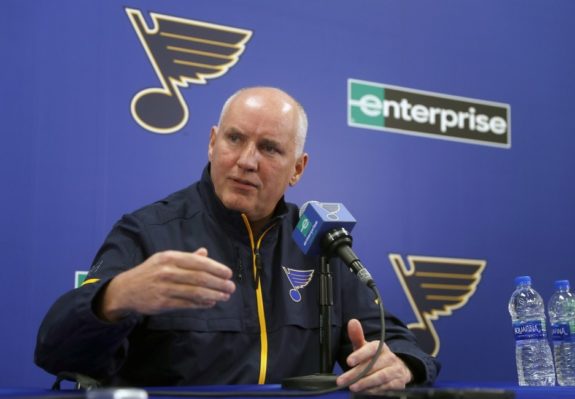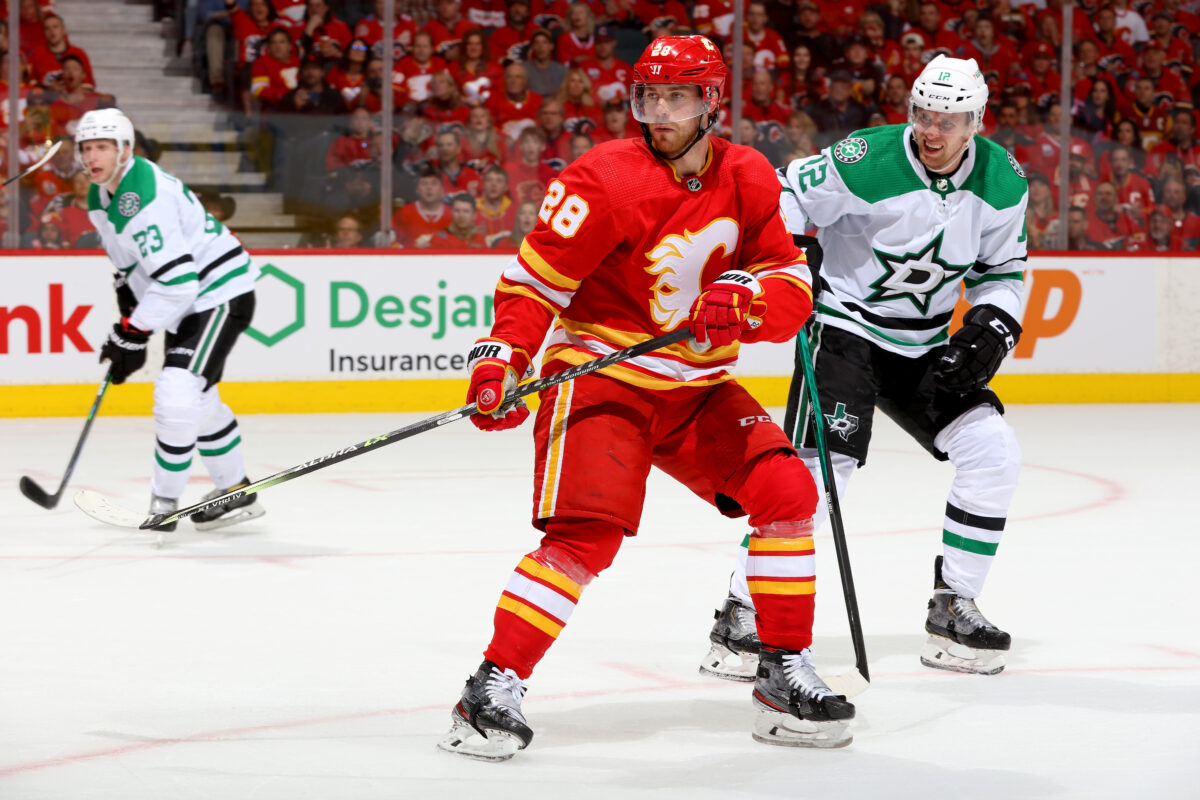The St. Louis Blues‘ struggles this season have placed them in a challenging position. Despite showing increased competitiveness since their head coaching change, they still have difficulty securing victories against top-tier teams. While there is ample time remaining in the season, concerns have arisen regarding the Blues’ current situation.

Given the abundance of top-end talent in their pipeline, the Blues may consider opening up roster spots for their promising prospects next season. Leveraging the trade deadline, especially with several players locked up long-term, could be a strategic move that benefits the organization. This approach would involve obtaining assets in return for players perceived as not critical to the team’s future.
Moreover, the team could explore trading players with veteran experience and four-line capability to contenders vying for the Stanley Cup. By doing so, the Blues could bolster their top six and enhance their overall competitiveness moving forward.
The Blues’ Top-Six Struggles
The Blues’ struggles this season can be attributed to several areas. Early in the season, they experienced a challenging stretch with goaltenders Jordan Binnington and Joel Hofer both being pulled in four consecutive games. Additionally, there were multiple occasions when the team couldn’t produce offensively, contributing to the decision to relieve former head coach Craig Berube of his duties. Despite the coaching change, with Drew Bannister now at the helm, the team’s record of 5-3 suggests a moderate turnaround.
Following Berube’s departure, general manager Doug Armstrong emphasized the need for change in the locker room. The first step was the coaching switch, and the second step has yet to be determined. To remain competitive, Armstrong must actively engage in the trade market, taking the initiative to reach out to other teams while also being receptive to potential offers. This proactive approach is crucial for steering the team in the right direction and addressing the challenges faced this season.
Will the Blues Be Buyers or Sellers?
Considering the points discussed earlier, the idea that the Blues should sell at the deadline seems probable. However, if the Blues are committed to competing, as indicated by Armstrong, a retooling strategy might be more fitting to align with their aspirations.
Opting to sell could pose difficulties for the Blues, as players they might consider selling haven’t delivered strong performances, limiting the potential return. Players like Brayden Schenn and Kevin Hayes may fetch only mid-round picks, falling short of the goal of acquiring high-end prospects and picks for a comprehensive rebuild. The Blues are not in a position that favors a complete overhaul.
The Blues’ decision to abstain from being buyers stems from their constrained financial resources, limiting their ability to make substantial investments. Furthermore, the team faces challenges due to a lack of depth and high-end talent, which hinders their ability to make a playoff run. While acquiring top-end players on the trade block may not align with the Blues’ current limitations, it could prove beneficial for the team’s immediate success. Balancing the desire for short-term gains with the realities of their financial and roster constraints becomes a crucial factor in strategic decision-making.
Related: Blues’ Poor Roster Construction is the Root of All Problems
Presently, the Blues showcase a formidable first line, featuring Pavel Buchnevich, Jordan Kyrou, and Robert Thomas, although it may not rank as the best in hockey. Nevertheless, challenges emerge when evaluating the composition of the remaining lines. Establishing Schenn in the center two spot poses challenges in constructing an effective line, considering his limitations in speed and production. An alternative configuration that places Brandon Saad on Schenn’s line alongside Hayes could enhance performance, yet it still falls shy of a formidable top-six line. Addressing these line challenges becomes pivotal for the Blues to optimize their offensive capabilities throughout the roster.
The top teams in the league have top-six forwards who exhibit strength. Many competitive teams have a second line that could even contend with the Blues’ first line in certain situations. To remain competitive, the Blues must focus on enhancing their top-end talent, which is currently lacking in comparison to other successful teams in the league.
While options for players fitting the Blues’ structure may be limited, there have been a few names circulating in trade talks that could be suitable additions. Here’s a look at some of these potential targets.
Players to Target at the Trade Deadline
Exploring potential names of interest for the Blues reveals that while there are several options, the number of realistically possible candidates is limited. Identifying a player who aligns with the Blues’ timeline, addresses their talent gaps, and comes at a reasonable price are challenging criteria to fulfill. Despite these challenges, there are still a few players the Blues could consider targeting.
Elias Lindholm, C, Calgary Flames
Rumors suggest that Elias Lindholm, 29, has been on the trade block at various points this season. As a consistent player for several seasons, Lindholm might be an option for the Blues. The Calgary Flames, facing challenges themselves, could consider a roster retool, which would make them a good trade partner.
The projected $4 million increase in the salary cap for the 2024-25 season provides the Blues with additional flexibility for potential moves. This, combined with the possibility of creating more cap space by trading away other players on the roster, positions the Blues well. Lindholm, who is set to become an unrestricted free agent after this season, could be a viable target, and there’s no reason why the Blues couldn’t present him with the contract he desires.

What would it take to get him? Well, as mentioned earlier, their team isn’t in bad shape, they just need to shake things up. Most likely, they’d consider one of the following options:
Option A: This option centers on the idea of the Blues offering additional value in exchange for Lindholm, rather than solely providing top-tier talent. While this may not align with the Flames’ ideal preferences, the proposal carries considerable value, including draft capital. Such a trade could offer immediate benefits for the Blues while providing a foundation for the Flames’ future.
Given the Flames’ uncertain direction, especially with Hanifin and Lindholm expressing interest in leaving Calgary, this trade scenario could be a pivotal component of a potential rebuild for the Flames. The exchange not only addresses the immediate needs of the Blues but also contributes to the Flames’ strategic efforts in reshaping their roster for the long term.
Calgary receives: Kasperi Kapanen, Zach Dean, 2023 2nd-Round Pick, 2024 4th-Round Pick
St. Louis receives: Elias Lindholm
Why this trade would work: Lindholm is a seasoned forward, possessing precisely what the Blues need: a blend of veteran leadership and goal-scoring prowess. Regarding why this trade benefits the Flames, consider what they gain. In Kapanen, they acquire a high-energy player suitable for all four lines. While he may not produce as a top-line player, his relentless play makes him standout on the ice. Coupled with former first-round pick Dean and draft capital, the Flames secure a bundle of assets that could contribute soon.
Option B: This option is straightforward and is the more likely path. In this scenario, the trade would involve the exchange of prospects and picks. To manage the salary cap implications when the extension kicks in, the team would then trade off another player with a higher salary to a contender. This approach aims to address both immediate roster needs through prospects and picks while strategically managing long-term salary cap considerations.
Calgary receives: Zachary Bolduc, 2024 2nd-Round Pick
St. Louis receives: Elias Lindholm
Why this trade would work: This trade, in contrast to the previous one, is direct and to the point. It involves a high-potential prospect along with a second-round pick in exchange for a player on an expiring contract, displaying little inclination to re-sign. This deal appears quite feasible. Bolduc stands out as one of the Blues’ premier prospects, showcasing significant goal-scoring prowess and adept passing skills. Despite a somewhat challenging start in the American Hockey League, he has recently found his stride and is getting back to the player that the Blues expected to get. Combining Bolduc’s talents with a top pick in the NHL draft, this trade holds promise for both teams.
Tomas Hertl, C, San Jose Sharks
Acquiring Tomas Hertl would undoubtedly strengthen the Blues’ lineup. His offensive skills and versatility make him a valuable asset, and the Blues should explore potential trade discussions with the Sharks to secure his services before the 2024 trade deadline.
Hertl’s situation with the Sharks presents an opportunity for both parties. With the Shaks being in a rebuilding phase, trading Hertl for younger players with contractual stability could benefit their long-term plans. For the Blues, acquiring a skilled forward like Hertl, despite his age, could provide an immediate impact and contribute to their competitive aspirations. Exploring trade possibilities with the Sharks would be a strategic move for the Blues.
San Jose Receives: Tyler Tucker, Zachary Bolduc, 2023 1st-Round Pick
St. Louis Receives: Tomas Hertl
Why this trade would work: Acquiring Hertl could provide the Blues with the offensive consistency they need in the top six. Offering a package including top prospect Bolduc, a solid defenseman in Tucker, and a first-round pick demonstrates a commitment to securing Hertl’s services. For the Sharks, gaining young talent, a promising defenseman, and a valuable draft pick aligns with a potential rebuilding strategy. This trade scenario appears to address the needs and timelines of both teams effectively.
Jake DeBrusk, W, Boston Bruins
With Jake DeBrusk’s contract expiring and the Bruins facing uncertainty, the Blues could capitalize on his recent offensive surge. If DeBrusk’s point streak continues, the Bruins might explore a trade to maximize the return. The Blues, positioned to make a move, could benefit from adding DeBrusk whose potential resurgence might be sparked by a change of scenery, aligning well with the Blues’ timeline.
Boston receives: Zach Dean, Brandon Saad
St. Louis receives: Jake DeBrusk, 2023 3rd-Round Pick

Why this trade would work: Saad, a veteran forward with significant playoff experience, is under contract for the next two seasons. Despite his lack of high-end skill, his Stanley Cup victories with the Blackhawks make him an appealing asset. However, the Bruins might not find him all that attractive. Including Dean, who has struggled but could benefit from a fresh start, adds value to the trade. Considering the Bruins’ limited prospect pool, acquiring Dean provides them with a promising player for the future. Combining Saad and Dean should be sufficient for a trade that aligns with the Blues’ cap situation.
Players Who Could Be Moved at the Trade Deadline
The potential movement of three, or possibly four, key players at the deadline—Schenn, Hayes, Saad, and maybe Binnington—raises questions about the expected returns in these trades.
Reflecting on Armstrong’s past trades, particularly last season’s involving players like Vladimir Tarasenko, Niko Mikkola, Ivan Barbashev, Noel Acciari, and Ryan O’Reilly, significant assets were acquired by the Blues, including two first-round picks. While these transactions had an impact, this season highlights the team’s need for top-six production.
Considering this context, the expected return for Schenn, Hayes, and/or Saad should align with Armstrong’s preference for valuable assets. This could include a combination of draft picks, prospects, and potentially established players to address the team’s immediate and future needs. The exact return would likely depend on the market, the player’s performance, and Armstrong’s negotiating skills in maximizing value. Blues fans can anticipate a strategic approach focused on bolstering the team’s overall competitiveness while considering both short-term and long-term objectives. If handled properly, those two things should align in the trades made.
Brayden Schenn
The prospect of trading Schenn to the Nashville Predators is intriguing, given Schenn’s contract situation and the potential benefits for both teams involved. Schenn, under contract for an additional four seasons, could be an appealing veteran presence for the Predators. The connection between Schenn’s close friend, former Blues captain O’Reilly, could make Nashville an intriguing spot for both parties. As for O’Reilly, he could make a compelling case for acquiring Schenn, leveraging the relationships he’s built with the Predators front office to enhance their roster.
For the Blues, the focus on acquiring players who contribute to immediate success while aligning with their timeline is crucial. The Predators, with a wealth of young talent, could offer valuable assets in return, providing the Blues with the win-now players they seek.
Overall, this trade scenario has the potential to benefit both organizations, with the Blues gaining assets for the present and the Predators acquiring a seasoned center to bolster their roster. The personal connection between Schenn and O’Reilly adds an extra layer of viability to this transaction.
Kevin Hayes
The analysis of Hayes as an in-betweener with contractual flexibility and a reasonable cap hit provides a solid foundation for exploring potential trade options. The New York Islanders as a primary landing spot for Hayes is well-reasoned, considering their current position in the Metropolitan Division and the specific needs of their roster.
The Islanders, with a mix of veteran talent but perhaps lacking a certain intangible quality, could benefit from Hayes’ attributes. His 200-foot game, penalty-killing effectiveness, and power-play capabilities align well with the Islanders’ style of play. The fit seems seamless, and Hayes could bring the missing element that the team is looking for to compete at a higher level.
The proposed trade scenario, where the Blues seek a mid-round pick or a right-handed defenseman prospect in return, appears reasonable. Addressing the Blues’ need for a right-handed defenseman while not asking for an exorbitant return makes this a feasible scenario.
Overall, the analysis provides a well-thought-out rationale for the potential trade of Hayes to the Islanders, considering the player’s profile, contract situation, and the needs of both teams involved.
Brandon Saad
Saad’s role with the Blues, his reliability, and the recognition of his veteran leadership provide a comprehensive understanding of his value to the team. The acknowledgment of Saad’s versatility and hockey IQ, despite not being a top-tier forward in terms of production, offers a unique perspective on his contributions.
Considering the Blues’ retooling phase and Saad’s age, exploring a trade, particularly with another AHL piece to potentially secure a top-six winger, is strategic thinking. Recognizing that Saad may not fetch a stellar return on his own due to his production levels, the idea of bundling him with another asset to target a top-six winger from an organization looking to move on from a pending free agent is a savvy approach.

The proposed trade scenario involving DeBrusk for Saad is well-reasoned, with both teams potentially benefiting from the exchange. This type of trade allows the Blues to address their retooling needs while acquiring a player who may be looking for a change of scenery. It also aligns with Saad’s versatility and leadership, which could be valuable for a team like Boston that is almost certainly going to be a Stanley Cup contender.
Overall, the analysis provides a thoughtful evaluation of Saad’s role, the challenges in obtaining significant returns, and a well-reasoned trade scenario that could benefit both the Blues and the Bruins.
What Would Come From These Moves?
The Blues’ ranking in standings and the lack of in-division games in the coming months provide context for the urgency in trying to compete and secure points. Recognizing the challenges in stumping in-division rivals for points, the emphasis on giving it their all becomes even more critical.
The proposed moves to trade key players like Schenn, Hayes, and Saad, align with the strategy of building the Blues’ future while also considering the immediate needs of the team. These moves could provide the edge necessary to compete effectively and bridge the team’s future to the present.
The emphasis on acquiring players more suited to the Blues’ timeline is a strategic approach that reflects a forward-thinking mentality. It not only addresses the current standings but also positions the team for success in the seasons to come.
Overall, the analysis provides a comprehensive understanding of the challenges the Blues face in their division, the importance of competing at a high level, and the potential impact of the proposed moves on the team’s trajectory. The focus on building for both the present and the future showcases a thoughtful and strategic approach to team management.
